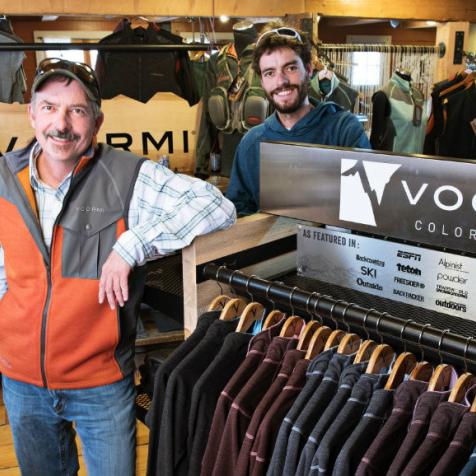
Company Details
Location
Pagosa Springs, Colorado
Founded
2010
Ownership Type
Private
Employees
10
Products
Technical apparel
Pagosa Springs, Colorado
Founded: 2010
Employees: 10
Industry: Lifestyle & Consumer
Products: Technical apparel
CEO Dan English leads the upstart technical-apparel manufacturer's development of cutting-edge designs and fabrics made for the harshest conditions on Earth.
English started VOORMI, named for a mythical race of arctic dwellers, with his son, Dustin.
Dustin had previously worked as a mountaineering guide in Alaska, and put some of the company's prototype garments to the test on the slopes of Denali, the highest peak in North America.

The father-son team moved to Pagosa Springs to launch their next-generation technical thermal base layers and outerwear. "Sometimes it's best to get a new perspective and design independently of the existing product strains," says English of the move. "Down here, we were able to design our products from scratch."
With a mission to manufacture in the United States and a focus on fabric innovation, the initial design phase lasted about two years. In the company's backyard, the San Juan Mountains offered an ideal testing ground.
"VOORMI is a company that's built around wool and built around the southern Colorado backcountry," says Timm Smith, director of brand marketing. "We have to build it a little tougher for the places we want to take it."
With more than 40 years experience designing technical fabrics, Doug Lumb led the design into new territory with high-altitude wool. "If you look at the development of the fabric, there are two aspects to it," Smith says. "It's where the source fiber comes from and it's what you do to it."
He explains that means "strategically" and "surgically" using synthetic materials in the best available wool.
"Wool from high elevations in the Rocky Mountains has some special characteristics," he says. "The sheep see temperature extremes in a day of 30-plus degrees. They grow a wool that's a little 'crimp-ier' than wool grown in a maritime climate." That makes for a garment that ultimately insulates better, thanks to tiny pockets of air in the fabric.

"It's not unlike coffee," says Smith of the company's trademarked Rocky Mountain Highcountry Merino. "Where the wool comes from really matters.
But the right wool is just step one. After sourcing wool Smith calls "the cream of the cream of the cream," VOORMI takes it to the next level with a process the company dubs "precision blending."
"We surgically introduce small amounts of synthetic fiber," says Smith. "We'll take a little bit of nylon and put it in the fabric in a very strategic way to make it more abrasion-resistant, or moisture-wicking, or water-resistant. What you get is a wool-based product that's been supercharged through these synthetic fibers without compromising the characteristics of the wool."
English is quick to note that the precision blending is done at the fabric level, not at the yarn level, and that requires talented sewers. "It allows us to maximize the properties of each fiber."
Debuting in early 2015, VOORMI's proprietary Core Construction "is a big breakthrough," says English. "It's the first overall single-layer performance fabric on the market. We've been able to integrate all sorts of weather protection in a single layer of fabric."
Another notable innovation is High Visibility Wool. "Wool absorbs light," says English. VOORMI's fabric makes it more reflective for hunting vests and other apparel that needs to be seen.

English says VOORMI's products are made in "Rocky Mountain region" and that retailers like the flexibility afforded by domestic manufacturing. "We continue to invest in manufacturing in small, rural communities," he says. "We've added more capacity in Pagosa -- we manufacture several of our products here. We're using approximately a half-dozen cut-and-sew locations in the United States, and are looking forward to growing it next year."
Adds English: "It's really about being nimble. It's something you can't do on a three-year product design cycle when you're manufacturing in Asia."
The VOORMI catalog now includes about 40 different products, including jackets, vest, neck gaiters, beanies, hoodies, and base and mid layers.
Sales have doubled on an annual basis. "We manage our growth responsibly," says English. "We could certainly grow much faster, but we want to stay within our headlights and not get in front of our skis."
Challenges: Manufacturing in the U.S. "Taking the rate of change in technological industries and applying it to the textile industry has been a challenge," says English. The major brands need to make a bigger commitment to domestic production to catalyze a true renaissance, he adds. "We need their help and leadership to rebuild for the long term. That's not happening."
"There's so much energy around U.S.A. manufacturing. But what we're seeing is [major apparel brands] may have picked one or two items out of literally thousands to make in the U.S., then they dangle the opportunity of bringing their entire line back."
"Lead times for raw materials continue to be a challenge," he adds. "We'd like to see the entire supply chain make gains in efficiency."

Opportunities: "To continue to bring different technologies and a different perspective to the clothing and apparel world," says English. "VOORMI's really focused on engineered fabrics. That's probably a new term."
Creating jobs in the Pagosa Springs area is another opportunity, he adds. "We made a very deliberate choice to locate the company in southwestern Colorado. We felt it was our responsibility to create jobs in economically challenged areas. The opportunity for VOORMI is to grow and bring jobs to this area -- that's the real opportunity."
Needs: Better manufacturing-oriented education and career tracks. As the apparel industry moved production to other countries, the labor pool shrank. "Through that abandonment, the skill base began to dry up," says English. Now he says there's a serious need for higher education and job training to revisit the industry. "Very few people look at cut and sew as a viable career path."
